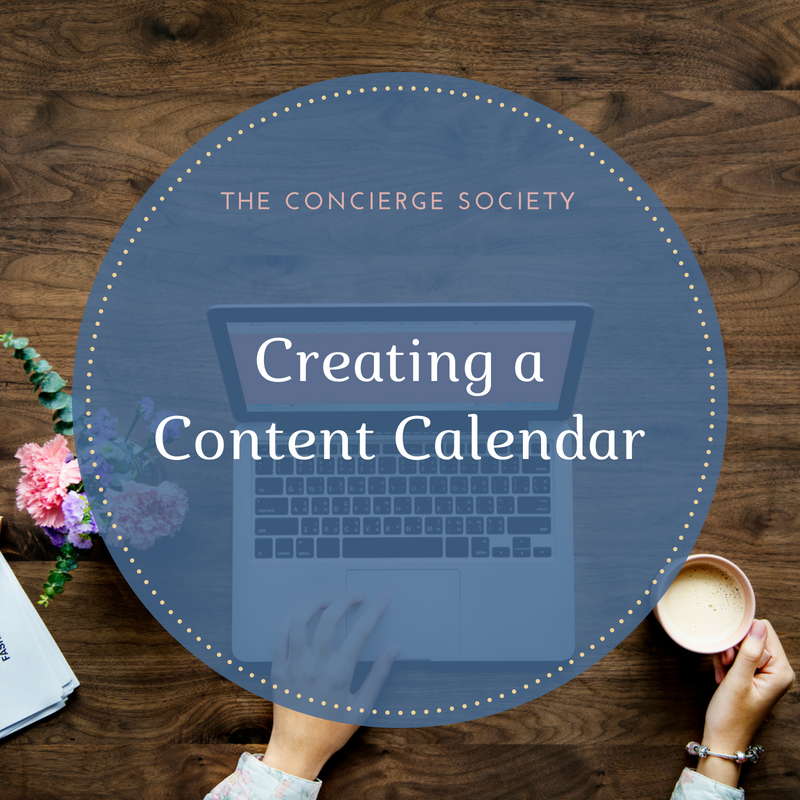Creating a Content Calendar


Creating content should be a key part of your marketing strategy. Creating and delivering consistent content can make a dramatic difference to the awareness and growth of your business. It’s also the best way to improve your SEO (Search Engine Optimisation) to help Google and other search engines, and thus your clients, find you. Yet, it can be quite overwhelming, as well as difficult to maintain, as things get busier in your life and your business.
This is why I recommend that you create a Content Calendar, to take the burden off you to come up with ideas and consistently deliver content with your audience.
What type of content can I create?
Content comes in many forms, but four broad categories of content are:
- Written
- Audio
- Video
- Visual
You may choose to focus on only one of these mediums or you may combine 2, 3 or all as part of your content strategy. What you choose will come down to what suits you, and which type of content your ideal client is most likely to consume.
Now, assuming you have worked out which type of content you want to create, and how you are going to create it (blog post, e-newsletter, video, podcast, infographic) you now need to (a) come up with ideas and (b) create a content calendar which ensures you can consistently deliver for the long term.
What are the key elements of a content calendar?
Below are the steps that I have personally used when creating my own content calendar. All of these can be tweaked to suit your own needs, but are a great base line for you to start with.
1. Come up with a monthly topic
I like to allocate a particular topic to each month as it (a) makes it easier for me to come up with content ideas and, (b) means I’m not doubling up on content or missing out on sharing great content. As a personal concierge, you may have a time management month, an organising month, a summer holidays month or a getting ready for the holiday season month. Or, you may choose to focus, for example, soley on time management, and focus on a different time management topic each month. Don’t forget to consider both seasonal topics such as Mother’s Day, Easter etc. as well as evergreen topics, those topics which are relevant all year round.
2. Decide the type content are you going to share each month
This is where you need to consider which content you are happy to produce. What will you be able to create for the long term? Are you a great writer? Do you love putting your thoughts down on paper? Do you think that a podcast could be perfect for you? Will you have the right equipment to record, and enough quiet moments in your life to actually plan and record your show? There is no right or wrong choice here, as long as it is something feel you can create great content, with real value, and maintain it for the long term.
The other thing you need to consider is what type of content your ideal client wants to consume. This could be trial and error for a few months, especially as you evaluate if your ideal clients are more video consumers or blog post consumers, for example. Just remember, if you in the early stages decide to host a weekly podcast show, and then six months in that none of your ideal clients actually listen to podcasts, then you have potentially wasted a lot of time and money (although nothing is every truly wasted – as a podcast can easily be transcribed into written content or placed over video content).
3. Establish how much content you can reasonably create
Will you be able to produce a 5-minute video every week? Or is monthly a more reasonable expectation? Could you create this video and then also turn it into a written blog post? Do you want to create a regular blog post series where you interview successful mumpreneurs? In terms of the logisitics involved in conducting these interviews and writing the blog post, is a fortnightly series more suited, rather than a weekly series?
4. Consider how frequently you’re going to share your content
Do you want to share two facebook posts a day, one daily Instagram post, as well as pinning all your content to pinterest? How are you going to manage this? Will you need to find a scheduling program to do this, or are you comfortable with being a bit more ad-hoc?
5. Brainstorm content ideas
I find this bit the fun part! However, getting past ten ideas can be hard. One of the best ways to come up with ideas is to think about the types of questions you’ve received in the past from clients. Has a client asked you to explain how your services work? Has someone asked you where the best Italian restaurant is? Do you regular get asked where you find your organising products? Write down as many of these ideas as possible, and then find ways to break them down into even smaller parts. You could focus one piece of content on a blog post on how your grocery shopping service works, and another on how you organise to have a car serviced.
You also want to focus on both seasonal and evergreen content. What does that mean? Well, seasonal content relates to a certain time of year, such as Christmas or Father’s Day. You could repeat or repurpose this content, but only at certain times of the year. Evergreen content is the type that is relevant no matter what time of year it is. This means you could repost it on social media at various times of the year, or turn a video into a blog post to repurpose the content. There are lost of ways that you can be efficient with your content and maximise its usage.
6. Design your content calendar
There are many ways that you could go about designing your content calendar. You could draw it up on a whiteboard, use post it notes on the wall, create it within online software, or, as I do, use Excel. Here you can download a template based on the type of content calendar I use. I’m a big fan of colour coding, which you can do in a variety of ways, based on month, content type, or topic.
7. Create your content
Now that you have a plan laid out in front of you, it’s time to start creating your content. I find it useful to try and create content in batches. Perhaps you set aside half a day to write blog posts, or a day to film a video series. You may choose to spend two hours planning the content of five blog posts, with the goal of writing them by the end of the week. Don’t forget about the graphics you will want to create when you share on social media (I recommend Canva for this).
8. Measure and Review
When you first start creating content, its easy to just put it out there and hope for the best. However, how will you know what is the most popular content? How will you know what your ideal client prefers? This is where you need to become familiar with analytics. There are analytics available on most social media platforms to analyse post likes, shares etc. You can find out more about the various types of social media analytics here – Facebook Insights, Pinterest Analytics and Instagram Insights.
Most importantly, you need to be able to track the visitors to your website (I suggest Google Analytics) as well as the number of signups, readers and clicks with regards to your email marketing (I use Mailchimp). Take the time to get a handle on all of these options, and then ensure that you schedule regular time to track and review. Once you start to be come familiar with your most popular content, it make it easier for you to decide what content to create next.
I hope this has inspired you to work on your content creation strategy! Inside the Concierge Secret Society we have a ‘Content Marketing for the Personal Concierge’ training, which goes into more detail about what Content Marketing is, why it’s important, choosing which content type is best for you, how you can come up with ideas, and I also share some of my most popular content over the years.

Abbie Allen is the founder of The Concierge Society, as well as Lifestyle Elements and le Porter. She started Lifestyle Elements in 2004 at the age of 23 and now operates internationally from her head office in Adelaide, South Australia. She was the 2014 Institute of Concierge and Lifestyle Managers Association Golden Key Award winner, as well as a finalist in the South Australia Telstra Business Women’s Awards in 2012. She works with her husband Tim, and they have three daughters. If you handed Abbie a brand new book, a glass of red wine and some chocolate, plus the time to enjoy it, you would have made her day! Have you joined our free private community? Click here now!
